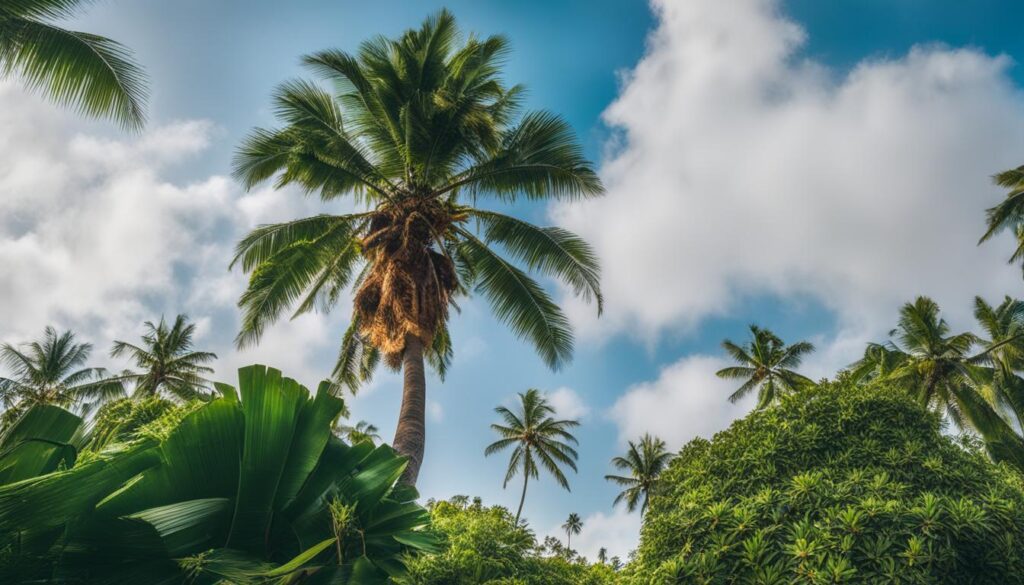Welcome to the fascinating world of palm trees! From their striking appearance to their delicious fruits, palm trees have captured the imagination of nature enthusiasts and gardening enthusiasts alike. In this article, we will take a closer look at the different types of palm trees, their unique characteristics, the fruits they bear, and where they thrive.
Palm trees are renowned for their diversity, with countless varieties found across the United States. Some popular types of palm trees include Areca Palm, Date Palm, Sago Palm, Ponytail Palm, Majesty Palm, Queen Palm, and Coconut Palm. These majestic trees can be easily identified by their large, evergreen leaves.
The Coconut Palm stands out among its peers as the only species that produces coconuts, while other palm trees bear fruits like dates, peaches, and acai berries. Palm trees display adaptability and can thrive in various climates, making them suitable for both indoor and outdoor growing. Some palm tree species are even hardy enough to withstand cold weather, making them an excellent choice for colder regions.
If you’re considering adding a touch of tropical beauty to your home or office, there are several palm tree options that thrive indoors. Popular choices for indoor palm trees include the Areca Palm, Majesty Palm, and Sago Palm, depending on the available space.
Palm trees are unique in their self-trimming nature, but they may require occasional pruning for maintenance. The lifespan of a palm tree can vary, with smaller varieties living for several decades and the Coconut Palm impressively reaching up to 90 years.
While palm trees are often used for decorative purposes, certain species like the Areca Palm are known for their air-purifying abilities, contributing to a healthier indoor environment.
Stay tuned for the upcoming sections where we dive deeper into the different types of palm trees and their fruits, as well as the environmental impact and sustainability of palm tree fruit production. It’s time to immerse yourself in the fascinating world of palm trees and discover the wonders they hold!
Types of Palm Trees and Their Fruits
Palm trees are not just beautiful and iconic, they also offer a variety of delicious and nutritious fruits. Let’s explore some of the most popular types of palm trees and the fruits they bear.
-
Coconut Palm: The coconut palm is renowned for its versatile fruits. Coconuts are widely consumed around the world. The oil extracted from coconuts is commonly used in cooking and skincare products, while coconut water is a popular beverage known for its refreshing taste and numerous health benefits.
- Date Palm: Originally native to the Middle East, date palms produce delicious and sweet fruits known as dates. Dates are a staple food in many cultures and are packed with vitamins, minerals, and fiber.
- Peach Palm: Found in Central and South America, the peach palm tree produces nutritious fruits. However, these fruits require long cooking times before they can be enjoyed. Once prepared, they offer a unique and tasty culinary experience.
- Oil Palm: The oil palm tree is primarily cultivated for palm oil production. Palm oil is widely used in various industries, including food, cosmetics, and biofuels due to its versatility and high nutritional value.
- Betel Nut Palm: Valued for their nuts, betel nut palms are often chewed for their mild stimulant effects. They are popular in many Asian countries and are an integral part of cultural and social practices.
- Snake Palm: Also known as salak, the snake palm is native to Java and Sumatra. Its fruits have a unique sweet and acidic taste when peeled, making them a delicacy in Southeast Asia.
- Jelly Palm: Found in South America, jelly palms are used to make alcoholic beverages. The fruits of these palms are known for their sweet and juicy flesh, making them a popular choice for jams, jellies, and desserts.
- Chilean Wine Palm: Traditionally tapped for sap to make fermented drinks, Chilean wine palms are native to Chile and Argentina. These majestic palms can grow up to 100 feet tall and are a symbol of the region’s rich wine-making heritage.
Environmental Impact and Sustainability of Palm Tree Fruit Production
Palm tree fruit production, specifically the production of palm oil, has a significant environmental impact. Large-scale palm oil plantations have resulted in widespread deforestation, leading to the loss of biodiversity and contributing to increased carbon emissions.
However, there is a growing focus on implementing sustainable practices in palm tree farming to mitigate these environmental consequences. Responsible palm tree farming involves integrating nature-based solutions, adopting sustainable land clearing practices, and implementing conservation measures.
Certification programs like the Roundtable on Sustainable Palm Oil (RSPO) have been established to promote best practices in palm oil production and encourage the use of sustainable palm oil. These programs ensure that palm oil is produced in an environmentally and socially responsible manner.
Furthermore, efforts are being made to explore sustainable alternatives to palm oil to reduce the negative environmental impact. Research and development initiatives are underway to find viable substitutes that can achieve similar functionalities without the adverse consequences.
As a consumer, you can play a role in supporting the sustainability of palm tree farming by choosing responsibly sourced palm oil products. Look for certification labels or products that proudly display their commitment to sustainable palm oil production. By making conscious choices, you can contribute to preserving our environment and promoting responsible palm tree farming.
– Can Palm Trees Thrive in the Virginia Climate?
Palm trees may struggle to thrive in the Virginia climate, as they are better suited for warmer, tropical environments. However, with the help of the best Virginia grass seed and proper care, it is possible to create a suitable environment for palm trees to grow and thrive in Virginia’s climate.









